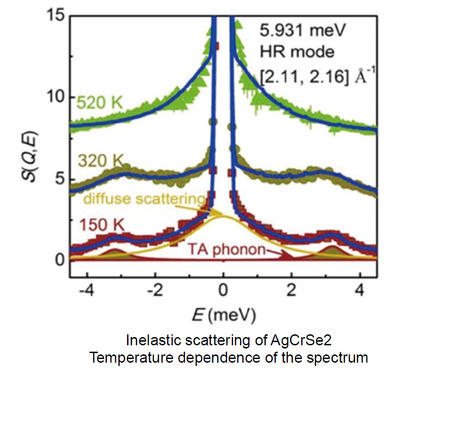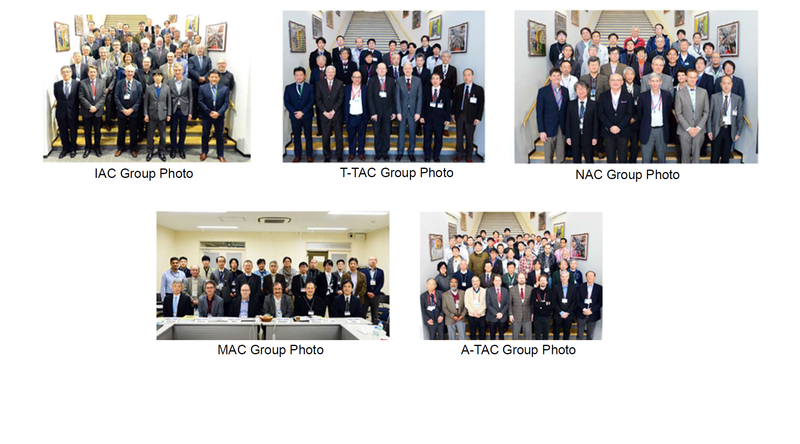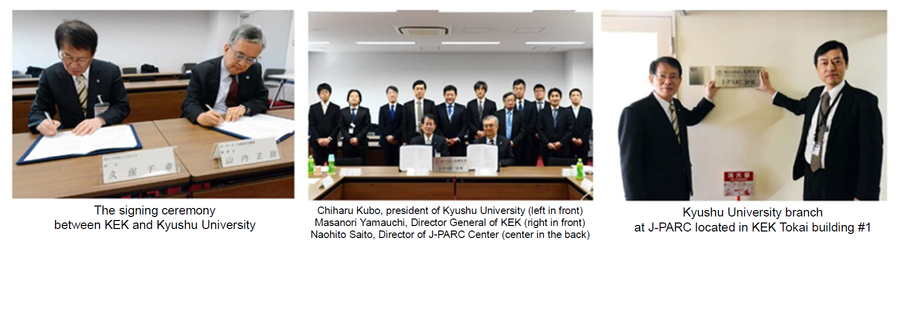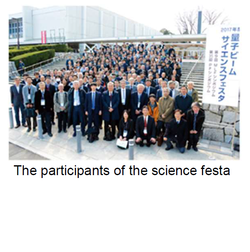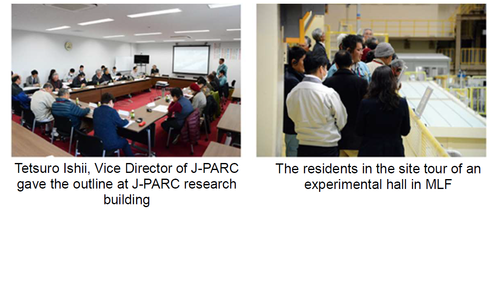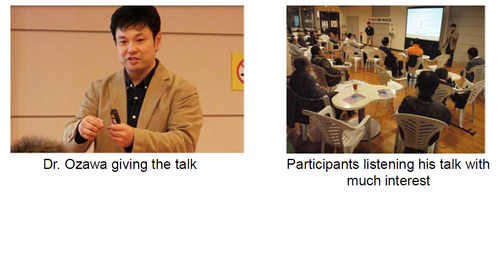J-PARC NEWS March 2018 (Issue #155)
■Beam Power to J-PARC Hadron Experimental Facility Exceeds 50 kW (January 31, J-PARC)
At the Hadron Experimental Facility, a 30 GeV beam was extracted for the first time from the MR accelerator in January 2009. Experiments were stopped due to the Great East Japan Earthquake, and later due to an accident and facility improvements to prevent recurrence, but operation was resumed in April 2015 at 24 kW, and gradually the beam intensity has been raised, with operation exceeding 50 kW achieved on January 31, 2018. At this facility, a diverse range of experiments are performed by colliding a proton beam with a gold target, generating K mesons, n mesons and other particles, and then using these secondary-particle beams. Researchers are investigating topics such as the properties of the "strong force" which acts in the atomic nucleus, the mechanism whereby the strong force gives rise to mass, and "CP symmetry breaking" which is the origin of today's universe with its preponderance of matter. The goal is to conduct elementary particle and atomic nucleus experiments using the world's highest-intensity proton beam exceeding 100 kW. As beam power increases, so does the number of secondary particles, and this makes it possible to increase the statistics of each experiment.

■Analysis of Characteristics of Advanced TRIP Steel Using Neutron Diffraction —New Findings for Development of Automotive Steel Sheet— (February 26, Press Release)
A research group made up of Stefanus Harjo (JAEA), Noriyuki Tsuchida (University of Hyogo) and others from the Neutron Science Section of the J-PARC Center have used the neutron beamline (BL19) "TAKUMI: High Performance Engineering Material Diffractometer" of the Materials and Life Science Experimental Facility (MLF) to carry out observation and analysis of changes in organizational structure when tensile force is applied to TRIP (Transformation Induced Plasticity) steel frequently used in structural parts such as automobile bodies. As a result, they succeeded for the first time in the world in achieving a previously difficult quantitative analysis of the fact that phase transformation of the crystal structure of TRIP steel due to external forces increases steel strength. These results were featured in the English science journal "Scientific Reports" on November 9, 2017.
■A New Path to Higher Performance of Energy Conversion Devices —Elucidation at the Atomic Level of Mechanisms Underlying Manifestation of Functions Provided by Irregular Structures of Layered Crystal Compounds— (March 15, Press Release)
A team lead by Bing Li (JAEA) of the Neutron Science Section of the J-PARC Center and Yukinobu Kawakita (JAEA), Leader of the MLF Disordered Materials Research Science Group, has shown that the high thermoelectric performance of AgCrSe2, a layered crystal compound, originates in a mechanism whereby the liquid-like behavior of a single-element layer of silver suppresses heat conduction. This was achieved by combining the results of pulsed neutron beam experiments including the MLF's Cold Neutron Disk Chopper Spectrometer (BL14), synchrotron radiation experiments at SPring-8, computer simulations, and theoretical calculations based on materials information science. This clears a new path for enhancing the function of thermoelectric materials. The results were featured in the English science journal "Nature Materials" on January 16, 2018 as joint international research by the JAEA, J-PARC, Japan Synchrotron Radiation Research Institute (JASRI), Comprehensive Research Organization for Science and Society (CROSS), U.S., Germany, and China.
■Held Meetings of J-PARC International Advisory Committee (IAC) and Other Committees (February 19 to March 6, J-PARC)
From February 19 to March 3, four advisory committee meetings were held for the Transmutation Experimental Facility (T-TAC), Muon Experimental Facility (MAC), Neutron Experiment Facility (NAC), and Accelerator Facilities (A-TAC). At these meetings, experts from both inside and outside Japan discussed and made suggestions on topics such as J-PARC accelerator and experimental facilities, the nature of research, and plans for the future. Following these meetings, J-PARC as a whole was discussed by the IAC on March 5–6. At each committee meeting, Naohito Saito, Director of the J-PARC Center, spoke on the current situation and future plans of all facilities. Then there were detailed explanations by the leaders of each experimental facility, discussion of reports on the response to suggestions received from the previous committee meeting, and reports on this fiscal year. At IAC, J-PARC received valuable suggestions for promoting results going forward.
■Established J-PARC Center Kyushu University Branch (March 2, J-PARC)
On March 2, a signing ceremony for a Memorandum of Cooperation between the High-Energy Accelerator Research Organization (KEK) and Kyushu University was held at the J-PARC Research Building, with Naohito Saito, Director of the J-PARC Center, and others in attendance. Following Osaka University in March 2016 and Kyoto University in February 2017, this memorandum establishes a J-PARC Center Kyushu University Branch in KEK Tokai Building No. 1, open for use by Kyushu University researchers and students carrying out joint research at J-PARC. It is expected that closer cooperative research relationships with universities can be achieved by establishing branch offices for each domestic university using J-PARC.
■Held FY2017 Quantum Beam Science Festa, 9th MLF Symposium, and 35th PF Symposium (March 2–4, Ibaraki Prefecture Cultural Center)
From March 2 to 4, the FY2017 Quantum Beam Science Festa was held in Mito city, with organizers such as the J-PARC Center, KEK Institute of Materials Structure Science, and Comprehensive Research Organization for Science and Society (CROSS). During the event, users of J-PARC MLF and PF (Photon Factory) gathered together in one venue, and engaged in lively discussions about research results achieved using quantum beams of synchrotron radiation, neutrons, and muons. The 9th MLF Symposium was held on the first day, and there were reports on new technology development at MLF and the current status of beamlines undergoing commissioning. As a first-time trial, a tour of MLF was held, and about 40 participants, mainly using synchrotron radiation at PF, entered the area of the MLF beamlines, where only experimenters are usually allowed, and received an explanation from the staff in charge of the equipment. A keynote address and parallel sessions were held on the second day, and on the third day, there was a review meeting on future plans for the MLF, organized by the Japanese Society for Neutron Science and the Society of Muon and Meson Science of Japan. The meeting ended successfully and attracted a large attendance of 524 participants overall.
■Second Meeting of FY2017 on Nuclear Power for Local Residents (February 19, J-PARC)
Tokai village holds meetings on nuclear power to introduce the nuclear power safety efforts of the village and project sites, solicit the views and desires of all residents, and incorporate those perspectives into "development of a safe and secure community." For this meeting, 14 people from the Kameshita District Residents' Association visited J-PARC together with the persons in charge of the meeting secretariat (Public Outreach, an NPO). There was an explanation of the purpose of the meeting by the Disaster Prevention and Nuclear Power Safety Section, and Tetsuro Ishii, Deputy Director the J-PARC Center, provided a general explanation of J-PARC. After that, the participants toured the MLF and Neutrino Experimental Facility, and described their impressions such as "I thought this you would be hard to understand, but taking the tour made it accessible."
■Held 14th J-PARC Hello Science "Let's Talk About the 'Really Strong Force'"(February 23, Tokai-mura Industry and Information Plaza "iVil")
This is a monthly science cafe held by the J-PARC Center. In February, the teacher was Kyoichiro Ozawa from the Hadron Section, and he talked about research at the Hadron Experimental Facility. Dr. Ozawa first explained initiatives in nuclear physics, and then pointed out that research at J-PARC is being conducted based on the core themes of "formation of hadrons from quarks" and "acquisition of mass due to the strong force." In particular, he discussed the strange properties of the strong force —for example, that unlike the electrical force it has three types of charge. Dr. Ozawa responded conscientiously to each of the many questions asked during his talk, and deepened his interaction with the participants. One of the older participants said, "the content of these events is difficult, but I always enjoy participating."


